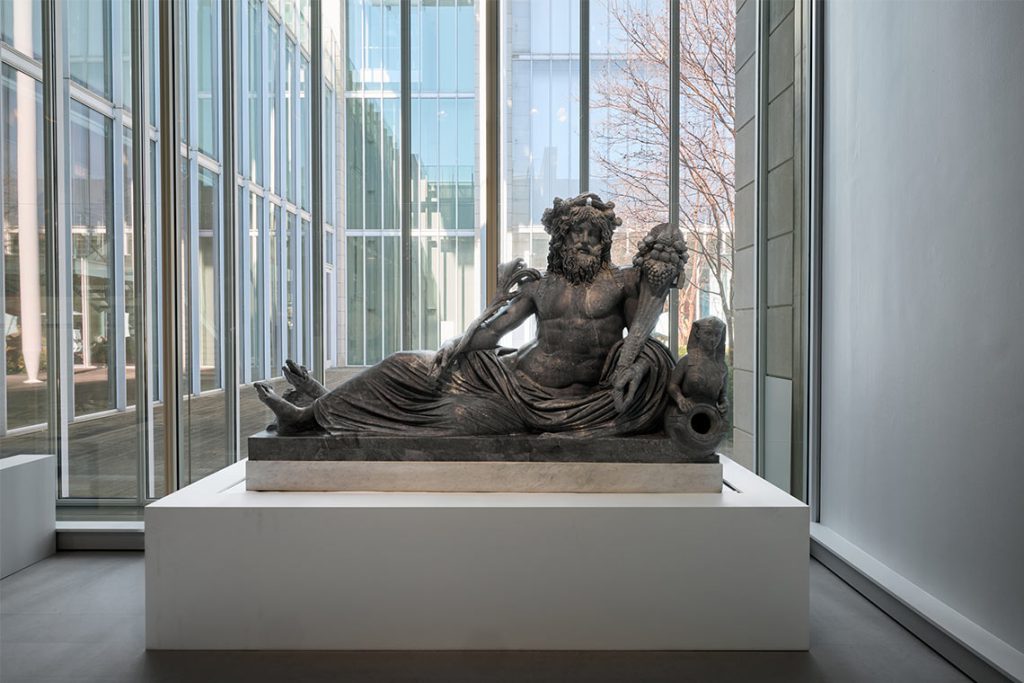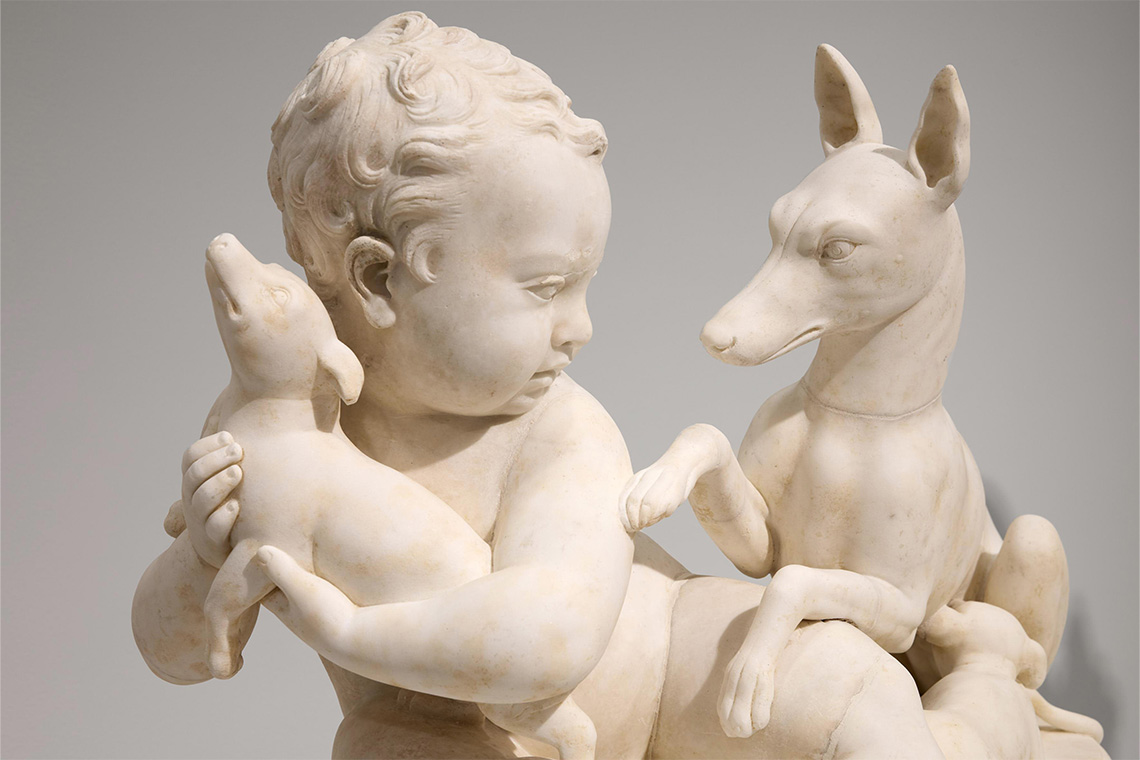The touring exhibition Myth and Marble: Ancient Roman Sculpture from the Torlonia Collection sees the newly created Fondazione Bvlgari partner with the Torlonia Foundation to showcase an exceptional range of restored ancient Roman marble sculptures.
Myth and Marble: Ancient Roman Sculpture from the Torlonia Collection is Bvlgari’s latest venture in an already longstanding tradition of preserving and disseminating culture through arts patronage. Fondazione Bvlgari, the Maison’s philanthropic branch established in 2024 and based in Rome, has overseen the restoration of more than 150 sculptures from the Torlonia Collection , which holds the world’s largest private collection of Imperial Roman sculptures. The exhibition sees 58 highlights tour North America, starting at the Art Institute in Chicago, where the exhibition was unveiled in March of this year and will remain until 29 June, then continuing to the Kimbell Art Museum in Forth Worth, Texas (14 September 2025–25 January 2026), before ending its journey at the Montreal Museum of Fine Arts (14 March–19 July 2026). It includes 24 recently restored works which have not been shown publicly in almost a hundred years and are now displayed for the first time outside Europe.
The Maison has long been known for its philanthropic endeavours, supporting local communities through investment in education, infrastructure, conservation and the arts. Dedicated especially to providing educational opportunities, Bvlgari has partnered with Save the Children for the past 15 years, as well as participating in Altagamma’s Adotta Una Scuola project and creating the Avrora Award in 2016, which seeks to platform inspiring female talents from various fields.

Image courtesy of Bvlgari and the Art Institute of Chicago
New York, the Maison continues to strengthen its presence as an international patron of the arts and culture sector, a role further cemented through the MAXXI Bvlgari Prize, a collaboration with the MAXXI Museum in Rome, created in 2017 and open to young creators making work in Italy, as well as through recent collaborations with artists at Milan Design Week. Since 2006 Bvlgari has also been an active player in the financing of numerous restoration projects, including the Spanish Steps in Rome, the mosaics of the Caracalla Baths and, most recently, the Piazza Augusto Imperatore.
The Maison now seeks to broaden its impact further through the creation of Fondazione Bvlgari, marking a new chapter in its wider philanthropy. “This deep commitment has constantly evolved over time, just as the most diverse needs dictated by global changes are never the same,” said Jean-Christophe Babin, Bvlgari CEO and President of Fondazione Bvlgari. “Now, with Fondazione Bvlgari, we have the opportunity to fully embrace this eternal metamorphosis by making an increasingly significant impact.”
In 2017, Bvlgari financed the restoration of 90 Roman statues from the Torlonia Collection, making the Maison’s involvement in an exhibition of the collection a natural next step. Curated by Lisa Ayla Çakmak and Katharine A Raff, Myth & Marble: Ancient Roman Sculpture from the Torlonia Collection is jointly organised by the Torlonia Foundation and the Art Institute of Chicago, in collaboration with the Kimbell Art Museum, the Montreal Museum of Fine Arts and The Museum Box. The exhibition’s works date from the fifth century BCE to the early fourth century CE, with a large portion of the collection on display dating from the apogee of the Roman Empire, during the first to second centuries CE.
Six sections showcase the exceptional body of marble sculptures collected by the Torlonia family over the years. In the section ‘Icons of the Torlonia Collection’, Portrait of a Young Woman, known as the Maiden of Vulci is on display, one of the three most historically significant sculptures from the Torlonia Collection. ‘Imperial Portraits’ highlights drawings from the second century CE of emperors and their families, while ‘Torlonia Excavations’ spotlights the many sculptures discovered during excavations on the properties of the Torlonia family in Rome and Porto, among them one of the oldest sculptures in the collection, Attic Votive Relief (end of fifth centuy BCE).

Image courtesy of Bvlgari and the Art Institute of Chicago
In the spirit of innovation so often found with Bvlgari projects, the section ‘Exceptional Restorations’ displays sculptural works which are the result of a modification of previously existing pieces, such as Rondanini Type Medusa on a Trapezophoros (Table Leg) with a Griffin’s Head, an amalgamation of two separate pieces of sculpture, a practice common during the Renaissance when artists sought to reimagine more ancient works.
‘Gods and Goddesses’ shifts the gaze towards the deities of the Roman world, emphasising the shared cultural heritage with Ancient Greece, while the final section, ‘Funerary Sculpture’, forefronts the ancient Roman tradition of honouring the dead. This selection of works, true gems in the Torlonia Collection, showcases a number of the largest marble Roman sarcophagi sculptures still in existence.
Through such exceptional objects, the Torlonia Collection’s world tour – supported from the start through the sculpture restoration project by Bvlgari – is expanding the reach and appreciation for these priceless cultural heirlooms like never before. In Myth and Marble: Ancient Roman Sculpture from the Torlonia Collection new audiences can enjoy the aesthetic and historical significance of these works, as well as the expert conservation work carried out by the Laboratori Torlonia (Torlonia Workshops). The collaboration underlines the Fondazione Bvlgari’s mission to champion heritage and highlights the Maison’s dedication to continuing as a key art patron in its home city of Rome.



